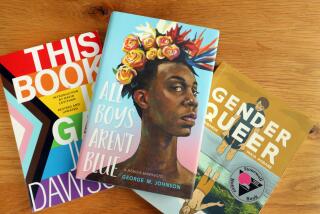American hero is fading away
CHICAGO — On the 100th anniversary of its publication, Helen Keller’s “The Story of My Life” would appear to be the book that has everything: a university tribute, a New Yorker article and a deluxe Web edition, scheduled to go online this fall.
In honor of the big event, two handsome new “restored” print editions, each at least 400 pages long, are on bookstore shelves.
And yet something is missing as Keller’s most famous book embarks on its second century.
A bestseller in its day and a classroom staple well into the 1970s, “The Story of My Life” now finds itself cut off from perhaps its most reliable supply of young readers. Forces ranging from the civil rights movement to the rise of video games and the death of Victorian values have pushed the book off public school reading lists, leaving it to face an uncertain future.
“The book has been unjustly forgotten and displaced in the schools, where [youngsters once] read it, and where it ought to be read,” says Roger Shattuck, an editor of the Norton restored edition of “The Story of My Life.”
Keller’s book, which recounts her experiences growing up deaf and blind in rural Alabama, started to disappear from schools in about 1985, according to Carol Jago, author of “With Rigor for All: Teaching the Classics to Contemporary Students.”
Today, Jago says, she doesn’t know a single person who teaches it.
“I think you could interview a lot of eighth-graders, and except for the jokes [about her disabilities], they wouldn’t really know who Helen Keller is.”
In Chicago public schools, the book, which used to be included on a list of 20 recommended for high school students, no longer appears on a similar (albeit shorter) list, according to Grace Bishop, a dean of students at Foreman High School.
At Borders Books on Michigan Avenue, a young cashier is jolted out of her rush-hour stupor by the sight of a hulking anniversary edition, emblazoned with a photo of Keller: “Did she write a book?”
The fate of “The Story of My Life” has long been linked to that of its author, and in the beginning, that was an unquestionable advantage. Keller, the daughter of a privileged Southern family, charmed the world with her tale of struggle and triumph.
Unable to see, hear or communicate at age 7 due to a childhood illness, Keller raged through her parents’ house like a wild animal. Not long after meeting her teacher, Anne Sullivan, she knocked out two of Sullivan’s teeth. But Sullivan persisted, spelling words into Keller’s hand until, in the now-famous water pump scene, the connection between word and meaning finally clicked.
“Suddenly I felt a misty consciousness as of something forgotten -- a thrill of returning thought; and somehow the mystery of language was revealed to me,” Keller wrote.
Keller, who published “The Story of My Life” while still a student at Radcliffe College, went on to become an advocate for the blind and the author of 13 books. “She was so famous that everyone knew who she was and followed her career with avid interest, not only ordinary people, but kings and queens and presidents,” says Dorothy Herrmann, author of the biography “Helen Keller: A Life.”
But after Keller’s death in 1968, her fame began to fade. Another factor in the book’s struggle has been the rise of multiculturalism, which has brought more books about ethnic minorities into the schools. Multiculturalism isn’t hostile to Keller, but as those stories get added, schools must cut other books.
Changing tastes and values also have created a challenge for Keller’s book. Her flowery style was admired in the sentimental and slow-moving Victorian era, but today’s readers may find it frustrating and pretentious.
Still, there are those who feel she’s been unjustly ignored. “Her story is part of America’s story,” Jago says. “It is part of cultural literacy.”
Nara Schoenberg is a reporter for the Chicago Tribune, a Tribune company.
More to Read
Sign up for our Book Club newsletter
Get the latest news, events and more from the Los Angeles Times Book Club, and help us get L.A. reading and talking.
You may occasionally receive promotional content from the Los Angeles Times.







